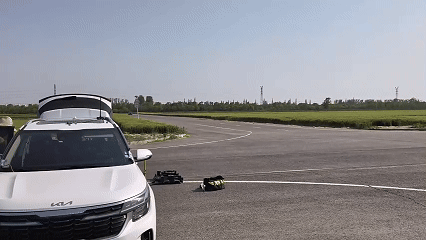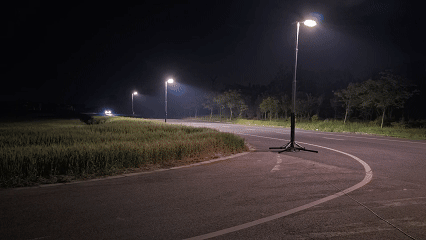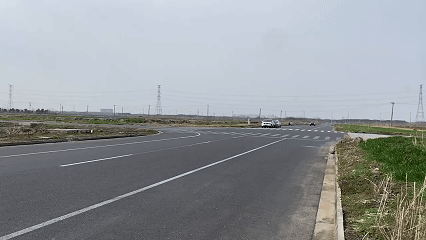Nullmax AEB System: Return to the Essence of Driving Safety
Date: 2025-05-30As automobiles are becoming increasingly intelligent, the AEB (Automatic Emergency Braking) system has always been a critical "must-have" for driving safety . Praised for its excellence in accident prevention and injury reduction, it is increasingly integrated into various vehicle models. Today, with the upgrade of camera, MMW (Millimeter-Wave) radar, and other sensor configurations, as well as the accelerated advancement of ADAS technologies, AEB systems are rapidly progressing toward high-performance and high-reliability benchmarks.
As a autonomous driving company, Nullmax believes that developing a mature, reliable, and high-performance AEB system requires not only efficient perception algorithms and highly reliable sensor hardware but also the establishment of a rigorous and comprehensive full-process development system. By strictly adhering to functional safety standards and combining a real-world/simulation testing verification system covering diverse scenarios, Nullmax ensures its AEB system can continuously monitor the surrounding environment, exhibit higher stability and reliability in sudden situations, trigger braking as quickly and appropriately as possible, and reduce collision risks.
Precise Perception, Visibility and Braking
Throughout its continuous iterative upgrades, Nullmax's AEB system always prioritizes reliability and safety. Through advanced AI algorithms and models, vehicles can accurately identify and locate dynamic/static obstacles. In practical applications, vehicles equipped with Nullmax's AEB system effectively avoid collision accidents and enhance driving safety in both high-speed and complex urban traffic scenarios. Additionally, Nullmax has introduced an algorithm monitoring strategy: if abnormal algorithm operation is detected, an immediate alert is issued to the driver.
Extensive real-world test data demonstrates that Nullmax's AEB system can achieve stable and precise emergency braking within a speed range of 4–85 km/h. Even in high-speed emergency scenarios at up to 120 km/h, it can rapidly respond, effectively decelerate, and initiate emergency braking.

Nullmax's AEB system has demonstrated superior capabilities in handling emergency traffic scenarios. Facing suddenly crossing pedestrians, bicycles, two-wheeled motorcycles, or stationary/moving targets in the same lane, the system leverages advanced perception algorithms to quickly and accurately identify threats and trigger immediate braking responses, effectively mitigating potential collision risks.

Nullmax also fully considers the impact of different lighting conditions on system performance, covering testing scenarios such as daylight, streetlight illumination at night to ensure stable and reliable operation under various lighting environments. Test results show that the false trigger rate of Nullmax's AEB system is less than 1 time per 1 million kilometers. Moreover, the system is continuously being iteratively optimized, with an even lower false trigger rate expected in the future, providing users with robust safety guarantees.


Upholding Driving 'Safety Red Lines'
The outstanding performance of Nullmax's AEB system stems from its strict adherence to functional safety development processes. During the system's R&D phase, Hazard Analysis and Risk Assessment (HARA) and Failure Mode and Effects Analysis (FMEA) are employed simultaneously. HARA systematically identifies potential risks, quantifies them by evaluating severity, occurrence frequency, and driver controllability, sets clear safety objectives for the system, and defines "safety red lines" from a top-down perspective. This ensures that active safety functions operate within reasonable risk parameters.
FMEA delves into the details of hardware and software, assessing potential failure points such as camera malfunctions or radar ranging deviations using Risk Priority Number (RPN) to evaluate severity, occurrence probability, and detectability. This drives targeted improvements such as sensor redundancy design and algorithm optimization, effectively reducing risks and enhancing overall system reliability.
Dual-Track Verification: Pursuing Truth and Accuracy
In the AEB testing and verification phase, Nullmax uses high-precision testing equipment to replicate real-world scenarios as accurately as possible. The testing team's "extended partners" include an array of simulation models for pedestrians, vehicles, and two-wheeled transportation. These models are made from special materials that highly replicate the physical dimensions, radar reflection characteristics, and visual features of real-world targets. Through repeated intensive testing, Nullmax's testing team works around the clock at the test site, simulating diverse scenarios to continuously enhance AEB safety performance.
Nullmax adopts a "real-world testing as the core, simulation testing as a supplement" dual-track verification model. While simulation testing offers cost-efficiency and high throughput, its overly idealized environment cannot fully replicate complex real-world road conditions. Therefore, Nullmax prioritizes real-world testing as the core verification method, complemented by the efficient data support of simulation testing, to improve testing efficiency while ensuring the reliability and precision of AEB systems in practical applications.
Nullmax adheres to a long-term development philosophy, with continuous investments in technological R&D—particularly in safety-critical products—driven by the mission to safeguard user safety. As Dr. Lei Xu, CEO of Nullmax, emphasized: "All our solutions and products have very clear safety design boundaries. When developing products closely related to safety, we need to clearly inform users of the product's safety boundaries and design scenarios, ensuring no exaggeration or misleading."
Conclusion
While high-level ADAS functions have become the industry's focus, active safety features, though seemingly understated, remain the core guarantee for users' driving safety. Nullmax takes "safety and reliability" as the driving force for technological R&D, integrating rigorous development processes and stringent testing standards throughout the product lifecycle, and using the warmth of technology to escort users' every journey.
Media Relations
media@nullmax.aiRelated Articles
- Nullmax Paper Accepted at ICCV 2025: HiP-AD Introduces a Novel One-Stage End-to-End Architecture for Autonomous Driving 2025-07-02
- Nullmax and Renesas Forge Strategic Partnership to Deliver Competitive ADAS Solutions for the Global Market 2025-02-25
- Nullmax's Vision-Only Tech: Eyes for Autonomous Driving and Robotics to Explore the World 2024-09-03
- Nullmax Launches 'Nullmax Intelligence': End-to-End Autonomous Driving Technology 2024-07-16
- Explore Autonomous Driving with MLF: More Efficient and Easier to Scale-Up 2024-06-03